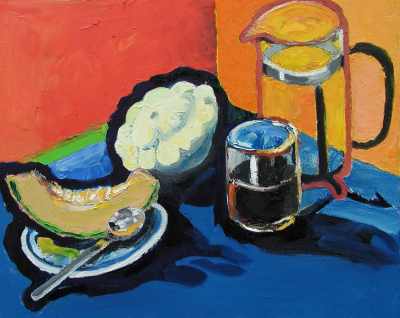¡Mezcal! Entendamos la bebida más de onda en los EE.UU.
Yo miraba mientras el joven, quién quería ser un mezcalero maestro, esperaba nerviosamente. Aquél joven vino a In Situ... la meca de mezcalerías... en dónde Ulises Torrentera, el Don de mezcal en Oaxaca, dedica cada día a su búsqueda para los mezcales más perfectos de Oaxaca. El joven le ofrecía una prueba a aquél romántico moderno, quién le parece mucho a Diego Rivera. Mientras probaba, el Don hacía unas preguntas antes de pronunciar un veredicto.
Para muchos americanos, pensar en mezcal es pensar en imágenes del actor Clint Eastwood en una de sus películas de vaquero con un cigarrillo en una mano y una botella de bebida con gusano en la otra. Sin embargo, como lo explica Ulises, ya no es así: el mezcal ya está ganando lugar entre los grandes licores del mundo, saliendo de las sombra de su hermano mayor, el tequila.
El mezcal, un licor embriagador que puede transportarte a un lugar de memorias increíbles, se está convirtiendo rápidamente en uno de los licores de onda en ciudades estadounidenses como Seattle y Chicago. Parte de ésta nueva popularidad es la gran variedad de mezcales que se producen en México, principalmente en el estado de Oaxaca.
En una entrevista que cubría desde terroir [es integralmente importante] hasta su deseo como niño de ser escritor, empezamos con la historia vieja del mezcal. Mezcal . . . un repaso El mezcal como lo reconocemos hoy tiene ya más de 400 años de edad, a pesar de la insistencia de algunas personas que es un éxito nuevo Descubierto y destilado por la gente indígena de México, el mezcal tiene una historia compleja. Por cierto tiempo, el mezcal sufría una persecución más común en los Estados Unidos. Acusado de ser responsable para todo tipo de maldad, su peor pecado fue que era la bebida preferida de las clases bajas para sus fiestas y sus celebraciones. La clase alta de México (la gran mayoría de ella siendo europea) lo echaba la culpa por el crimen, las enfermedades de niños, la violencia y la corrupción. Naturalmente, esto contribuyó a su prohibición. Llegamos a la primera mitad del siglo veinte y la industrialización de la producción de la tequila. México, con su cultura de machismo, aceptó a la tequila y tiró a un lado el mezcal, siendo que el mezcal tenía la reputación de ser algo bajo y primitivo. Pasando a la segunda mitad del siglo veinte, vemos que la versión moderna del mezcal tomaba forma en Matatlán, la Cuña del Mezcal, una región al este de la Ciudad de Oaxaca. El Maguey y el Proceso
iglos cuando la gente indígena de México descubrió que se podía hacer un alcohol fuerte por destilar la pulpa y los jugos del maguey y el agave. Después de cosechar el maguey, se lo concina en un horno volcánico invertido. Se lo muele con un muela antes de echarlo en tinas de madera para fermentar. Dependiendo del mezcalero, se lo puedo destilar varias veces y ponerlo en botellas para vender. Como dice Ulises, este proceso no se ha cambiado mucho a través de los siglos. El cambio más grande será las ollas de cobre, aunque algunos palenques siguen usando las ollas de barro. Hay tres tipos de magueys que se usan en la mayoría de los mezcales que vienen de Oaxaca. El más popular es el espadín. Alto con ramas que llegan a ser hasta dos metros, el espadín se madura en siete años. Aunque lleva años en madurarse, lo bueno es que se reproduzca fácilmente. Esta facilidad de reproducir explica la presencia de estancias en Oaxaca donde se puede encontrar miles de este tipo de maguey.
Ulises dice que esto es un crises. Si los intentos de proteger los magueyes silvestres no tienen éxito, no habrá cantidades suficientes de las plantas silvestres para satisfacer la demanda creado por la gente que quiere las matices que dan al mezcal. Hay que preguntarse qué haría la industria si de repente se encontrara una escasez. No hay muchos mezcaleros que quieren pensar en eso. En lugar de eso, escogen esperar que la naturaleza resolverá los problemas que se formen. Mientras confrontan este problema, algunos están decidiendo a mezclar varios tipos de magueyes como parte de su estrategia por sobrevivir. Estas esfuerzas en mezclar los sabores nos dan algo que la maestra mezcalera Cecilia Rios, La Niña de Mezcal, llaman “la belleza del mezcal”. La tequila se trata de la uniformidad, pero cada tipo de mezcal se diferente y nos provee con su propia aventura. Esto se atribuye en una parte a la gran variedad de los magueyes que se usan en la producción del mezcal; de otra parte, se atribuye al local donde se crece el maguey. Esto se llama “el terroir”. El Terroir Según lo que dicen muchos mezcaleros, el terroir es el factor que más influye el sabor del maguey y, por extensión, el sabor del mezcal. El medio ambiente, la tierra, la altitud y el clima se combinan en hacer un papel crítico. Un aficionado refinado puede distinguir las diferencias sutiles en las minerales, la flora local y el clima de la región donde se encuentre el maguey. Por eso, mucho screen que el palenque y el mezcalero deben de ubicarse muy cerca de su maguey. Es esta proximidad y familiaridad que hace el retrato completo. Por unirse con la tierra, conocer sus plantas y el ambiente local y por usar los procesos antiguos, el mezcalero completa el círculo con su antepasados. Como dice Ulises, esto es indispensable. Yo le pregunté a Ulises si piensa que el mezcal llegará a ser más popular en los Estados Unidos. Me dijo que esperaba que no, porque él quiere que la gente venga a Oaxaca para probar los grandes mezcales. ¿Por qué? Porque Oaxaca es mezcal y mezcal es Oaxaca! (c) Copyright Dave Miller 2013 - 2016. All Rights Reserved. Translated by Brian Cumings Labels: Cecilia Rios, Espadin, gastronomy, In Situ, La Nina de Mezcal, Madre Cuishe, Matatlan, mexico, Mezcal, oaxaca, Terroir, Tobala, Tourism, Ulises Torrentera, Wahaka Mezcal |

























